| Article ID | Journal | Published Year | Pages | File Type |
|---|---|---|---|---|
| 790797 | International Journal of Pressure Vessels and Piping | 2011 | 9 Pages |
When an anisotropic material is subject to creep conditions and a complex state of stress, an anisotropic creep damage behavior is observed. Previous research has focused on the anisotropic creep damage behavior of isotropic materials but few constitutive models have been developed for anisotropic creeping solids. This paper describes the development of a new anisotropic tertiary creep damage constitutive model for anisotropic materials. An advanced tensorial damage formulation is implemented which includes both material orientation relative to loading and the degree of creep damage anisotropy in the model. A variation of the Norton-power law for secondary creep is implemented which includes the Hill’s anisotropic analogy. Experiments are conducted on the directionally-solidified bucket material DS GTD-111. The constitutive model is implemented in a user programmable feature (UPF) in ANSYS FEA software. The ability of the constitutive model to regress to the Kachanov-Rabotnov isotropic tertiary creep damage model is demonstrated through comparison with uniaxial experiments. A parametric study of both material orientation and stress rotation are conducted. Results indicate that creep deformation is modeled accurately; however an improved damage evolution law may be necessary.
► The deformation of anisotropic creeping solid is directionally dependent. ► Few constitutive models have been developed to deal with anisotropic behavior. ► A transversely-isotropic nickel base superalloy, DS GTD-111, is studied. ► A vector constitutive model based on the Kachanov-Rabotnov formulation is developed. ► The new model accurately models deformation at various orientations.
